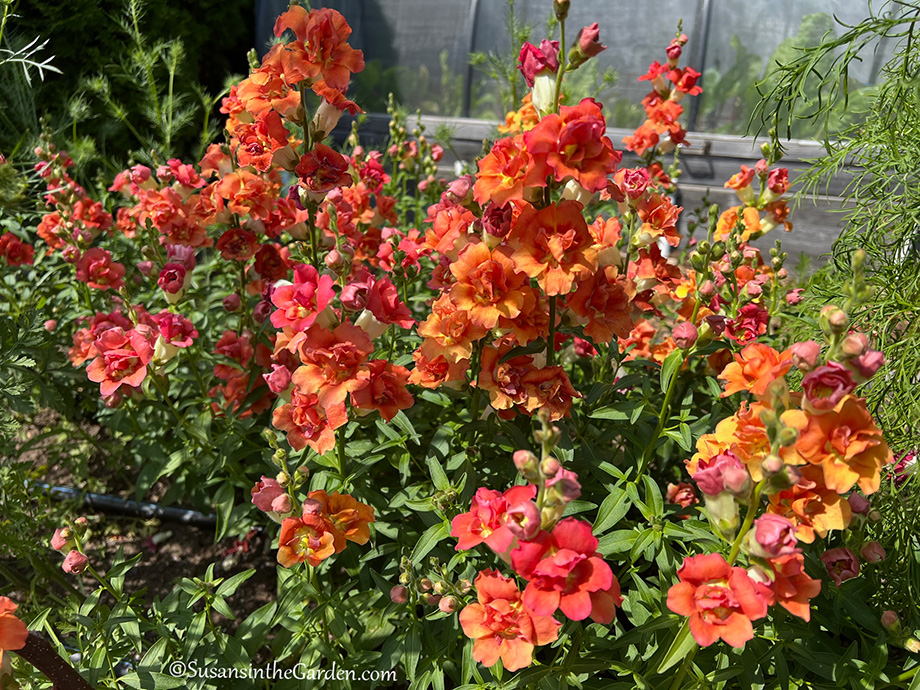Column: Awesome Annual Flowers

While there are so many wonderful perennials that brighten up our gardens at various times during the growing season, I think annual flowers are the workhorses. They are the subject of my garden column for today.
Annuals are plants that grow, bloom, set seed and die in a single growing season. Examples include marigolds, nasturtiums, zinnias and cosmos.
I hope you’ll enjoy learning more about annual flowers and perhaps add some of the highlighted ones to your garden next year!
by Susan Mulvihill
As much as I appreciate the benefits of growing edible crops, my garden wouldn’t be complete without lots of flowers.
The biggest benefit of growing flowers is that they attract beneficial insects and pollinators. But I also enjoy the colors and shapes of different flowers.
Earlier this year, I started several varieties of annual flowers from seed as part of my “Seed-Starting Demystified” video series. Annuals grow, bloom, set seed and die in a single growing season. I selected some plants that I’d never grown before and others that required special seed-starting treatment so I could demonstrate the different techniques in the videos. (note: you can find links to this year’s “Seed-Starting Demystified” videos by going to this page on my website.
I transplanted the young seedlings outdoors in May. As soon as they started blooming, I knew they were worthy additions to my garden. Most are All-America Selections award winners which means they have outstanding attributes.
Coleus Sun Coral Candy _ This was the first time I’d ever started coleus from seed and it was easy. Coleus is prized for its colorful foliage that is just as pretty as a blooming plant. Sun Coral Candy leaves have a stained-glass appearance and serrated edges. The plants grow up to 16 inches tall. I paired them in a container with a lovely coral begonia and a trailing petunia with similarly-colored blossoms. (note: This beauty is pictured at the very top of this post)
Cosmos Apricotta _ The 3-inch apricot petals with narrow lavender stripes provide a lovely contrast to the yellow center. Between the eye-catching blossoms and delicate, fernlike foliage, this plant is really attractive and will bloom prolifically if you remove the spent flowers. The plants will grow up to 42 inches high.
Love in a mist (Nigella) Miss Jekyll _ This plant is an old standby because it has a lot going for it. The sky-blue blossoms are surrounded by delicate foliage. Each bloom morphs into an intriguing, puffy seed capsule, adding even more interest to the garden. The plants will grow 12 to 18 inches tall. Love in a mist is a staple in English cottage gardens, which I seem to be trying to emulate here in Spokane.
Painted tongue (Salpiglossis) _ I’ve grown this plant before and really treasure the gorgeous trumpet-like flowers. I chose the Superbissima blend because it produces magenta, purple, yellow or red blooms. This is a flower that gardeners should stop to admire. The plants will grow 24 to 36 inches tall and thrive in cooler weather.
Purpletop Vervain (Verbena bonariensis) Vanity _ English gardeners frequently extol the virtues of Verbena bonariensis, which can grow up to 6 feet tall. You can imagine how excited I was to learn that Vanity will only grow about 30 inches tall, which seems more doable in a flower border. Its open habit means the plant won’t block other plants around it but instead provide lovely lavender-colored floral accents here and there.
Snapdragon (Antirrhinum) Doubleshot Orange Bicolor _ This is not your grandmother’s snapdragon. How about a profusion of double, coral-and-white blossoms to brighten up your garden? They also make great cut flowers. I’m particularly excited that they are tolerant to light frosts which means they’ll be one of the last flowers blooming late in the season. The plants grow up to 20 inches in height.
Zinnia Profusion Red-Yellow Bicolor _ I’ve grown zinnias for years and am especially fond of the Profusion series because they have a compact growth habit and a wealth of bright blooms. They love the sun and will grow about 14 inches tall.
Susan Mulvihill is author of “The Vegetable Garden Problem Solver Handbook” and “The Vegetable Garden Pest Handbook.” She can be reached at Susan@SusansintheGarden.com. Watch Susan’s videos at youtube.com/susansinthegarden.

